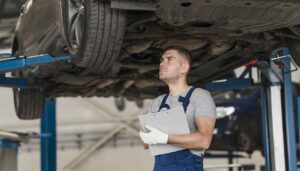Keep Your Wheels Rolling Longer with These Essential Tire Maintenance Tips

Introduction
Tire maintenance is often overlooked, but it’s crucial for keeping your vehicle safe and efficient. Neglecting your tires can lead to poor performance, reduced fuel efficiency, and even dangerous blowouts. This blog post aims to provide car owners and DIY enthusiasts with practical tips on extending the life of their tires. You’ll learn how to identify signs of wear, maintain proper tire pressure, and much more. Read on to discover how a little care can go a long way in keeping your wheels rolling smoothly.
Signs Your Tires Need Maintenance
Uneven Wear and Tear
Uneven tire wear is a common indicator that your tires need attention. When tires wear unevenly, it usually means they aren’t making proper contact with the road. This can lead to a rougher ride and diminished handling capabilities. If you notice one part of your tire wearing out faster than the rest, it’s time to take action.
Tires that wear unevenly often signal deeper issues like poor alignment or unbalanced tires. Ignoring this can compromise your vehicle’s stability, making it harder to control. Regularly inspecting your tires for uneven wear can help you catch problems early before they escalate.
Visual checks are the first step. Look for any bald spots or unusually smooth areas. Use a tread depth gauge for a more accurate assessment. If you find significant discrepancies, it’s best to consult a professional.
Low Tire Pressure
Maintaining the correct tire pressure is essential for the longevity of your tires. Low tire pressure can result in poor fuel efficiency and increased tire wear. It also makes your vehicle harder to handle, especially during emergency maneuvers.
You should check your tire pressure at least once a month. Under-inflated tires can cause the tire’s sides to flex more, leading to overheating and potentially a blowout. Over-inflated tires, on the other hand, can make your ride harsh and lead to uneven wear.
Use a reliable tire pressure gauge to check each tire, including the spare. Refer to your vehicle’s manual for the recommended pressure levels. Keeping your tires inflated to the correct pressure ensures optimal performance and safety.
Visible Damage
Physical damage to your tires can occur from road debris, potholes, or even curbs. Cuts, punctures, and cracks are obvious signs that your tires need immediate attention. Driving on damaged tires is risky and can lead to sudden tire failure.
Regularly inspect your tires for any visible signs of damage. Small punctures can often be repaired, but larger cuts usually mean the tire needs to be replaced. It’s better to be safe and replace a damaged tire than risk a blowout.
If you notice any bulges or blisters on the tire’s sidewall, it’s a sign of internal damage. These tires should be replaced immediately to avoid catastrophic failures. Don’t take chances with damaged tires; always err on the side of caution.
How to Check and Maintain Tire Pressure
Importance of Correct Tire Pressure
Maintaining the correct tire pressure is not just about extending the life of your tires; it’s also crucial for safety. Properly inflated tires ensure better contact with the road, offering improved traction and handling. This becomes particularly important in wet or slippery conditions.
Incorrect tire pressure can lead to various issues, including poor fuel economy and increased tire wear. Under-inflated tires create more rolling resistance, which means your engine has to work harder. This results in higher fuel consumption and reduced mileage.
On the flip side, over-inflated tires reduce the contact area with the road, leading to uneven wear and a harsher ride. It’s essential to strike the right balance by maintaining the recommended tire pressure for your vehicle.
Step-by-Step Guide on How to Check and Fill Tires
Checking and maintaining your tire pressure is a straightforward process. Here’s a step-by-step guide to help you get it right:
- Gather Your Tools: You’ll need a tire pressure gauge and an air compressor. Many gas stations have air compressors available for public use.
- Check the Pressure: Remove the valve cap from one of your tires and press the tire pressure gauge onto the valve stem. Read the gauge to see the current pressure level.
- Compare with Recommended Levels: Refer to your vehicle’s manual or the sticker on the driver’s side door jamb for the recommended tire pressure. Compare this with the reading from your gauge.
- Adjust as Needed: If the tire pressure is too low, use the air compressor to fill the tire to the recommended level. If it’s too high, release some air by pressing the small pin inside the valve stem with the gauge.
- Repeat for All Tires: Don’t forget to check the spare tire as well. It’s just as crucial for safety.
- Replace Valve Caps: Once all tires are correctly inflated, replace the valve caps to keep out dirt and moisture.
Regularly checking and maintaining your tire pressure can significantly extend the life of your tires and improve your vehicle’s overall performance.
Tire Rotation and Balance
Explanation of Why Rotation and Balance are Necessary
Tire rotation and balance are essential practices for maintaining even wear and extending the life of your tires. Rotating your tires means moving them from one position to another, such as from front to back or side to side. This helps distribute wear evenly across all tires.
Balanced tires ensure that the weight of the tire and wheel assembly is evenly distributed. Unbalanced tires can cause vibrations, making your ride uncomfortable and leading to uneven wear. Both rotation and balancing improve handling and extend tire life.
Ignoring these practices can lead to premature tire wear and may even contribute to mechanical issues in your vehicle. Regular rotation and balance checks are simple yet effective ways to maximize tire longevity and performance.
Frequency and DIY Tips
Tire rotation should be done every 5,000 to 8,000 miles, or as recommended by your vehicle’s manufacturer. A good rule of thumb is to rotate your tires every time you change your oil. This keeps your tires wearing evenly and improves their lifespan.
Balancing should be checked whenever you notice vibrations while driving, especially at higher speeds. It’s also a good idea to balance your tires every 6,000 to 8,000 miles or when rotating them.
For DIY enthusiasts, rotating and balancing tires at home is possible but requires specific tools like a car jack, jack stands, and a torque wrench. Always follow safety guidelines and consult your vehicle’s manual for the correct rotation pattern and torque specifications.
Aligning Your Tires
Understanding the Need for Proper Alignment
Proper tire alignment ensures that your vehicle’s suspension components are adjusted correctly, making your tires contact the road as designed. Misalignment can lead to uneven tire wear, poor handling, and decreased fuel efficiency.
Alignment issues often arise from impacts like hitting a pothole or curb. Symptoms include your vehicle pulling to one side, uneven tire wear, and a crooked steering wheel when driving straight. Addressing alignment issues promptly can save you from costly repairs down the line.
Correct alignment not only extends tire life but also improves overall driving comfort and safety. Regular alignment checks, especially after significant impacts, are vital for maintaining vehicle performance.
Signs of Misalignment and How to Adjust
Common signs of misalignment include uneven tire wear, your vehicle pulling to one side, and a steering wheel that isn’t centered. If you notice any of these symptoms, it’s time for an alignment check.
Alignment adjustments should be done by professionals using specialized equipment. However, understanding the basics can help you communicate better with your mechanic. The three main alignment angles are:
- Camber: The tilt of the tire when viewed from the front of the car. Incorrect camber causes uneven tire wear.
- Toe: The direction the tires point relative to the centerline of the vehicle. Incorrect toe settings can lead to tire scrubbing and accelerated wear.
- Caster: The angle of the steering axis when viewed from the side. Incorrect caster affects the vehicle’s stability and steering.
Regular alignment checks, especially after hitting a pothole or curb, can prevent uneven tire wear and improve your vehicle’s handling.
Choosing the Right Tires
Factors to Consider When Selecting Tires
Choosing the right tires for your vehicle is crucial for safety and performance. Factors to consider include the type of driving you do, the climate you live in, and your budget. All-season tires are a popular choice for their versatility, but specialized tires like winter or performance tires may be better suited for specific needs.
Tire size and load rating are also important considerations. Always refer to your vehicle’s manual for the recommended tire size and specifications. Choosing the wrong size can affect your vehicle’s handling and safety.
Additionally, consider the tire’s tread pattern and rubber compound. These factors influence traction, noise levels, and wear rate. Investing in quality tires tailored to your driving conditions can enhance your vehicle’s performance and safety.
Overview of Different Tire Types and Their Benefits
There are various types of tires, each designed for specific conditions and driving styles. Understanding the differences can help you make an informed choice:
- All-Season Tires: Versatile and suitable for most driving conditions. They offer a balanced performance in wet, dry, and light snow conditions.
- Winter Tires: Designed for cold weather and snowy conditions. They have deeper treads and softer rubber compounds to maintain traction in low temperatures.
- Performance Tires: Built for high-speed handling and cornering. They offer superior grip and responsiveness but may wear out faster than other types.
- Off-Road Tires: Ideal for rugged terrains and off-road adventures. They have aggressive tread patterns for enhanced traction on dirt, mud, and gravel.
Selecting the right tire type based on your driving needs can significantly improve your vehicle’s performance and safety.
Storing and Seasonal Tire Maintenance
Tips for Storing Tires Properly
Proper tire storage is essential for maintaining their condition when not in use. Store tires in a cool, dry place away from direct sunlight and heat sources. Exposure to UV rays and extreme temperatures can cause the rubber to deteriorate.
If possible, store tires vertically to prevent deformation. Use tire covers to protect them from dust and moisture. Avoid placing heavy objects on top of stored tires, as this can cause flat spots.
Before storing, clean the tires thoroughly to remove dirt and debris. Applying a tire protectant can also help preserve the rubber. Proper storage extends the life of your tires and ensures they’re ready for use when needed.
Seasonal Changes and Their Impact on Tire Maintenance
Seasonal changes can significantly impact tire performance and maintenance. In cold weather, tire pressure drops, which can lead to under-inflation and increased wear. Check and adjust tire pressure regularly during winter months.
Winter tires are essential for regions with heavy snowfall and icy roads. Their specialized rubber compounds and tread patterns provide better traction and handling in cold conditions. Switch to winter tires before the first snowfall to ensure safety.
In warmer months, higher temperatures can cause tire pressure to increase. Over-inflated tires can lead to uneven wear and reduced traction. Regularly monitor tire pressure and adjust as needed to maintain optimal performance.
Conclusion
Regular tire maintenance is essential for extending the life of your tires and ensuring your vehicle’s safety and performance. By paying attention to signs of wear, maintaining proper tire pressure, and performing regular rotations and alignments, you can keep your tires in top condition.
Remember to choose the right tires for your driving needs and store them properly when not in use. By following these tips, you can save yourself from costly repairs down the line and enjoy a comfortable and safe driving experience. So, make sure to include regular tire maintenance checks on your vehicle’s maintenance schedule and communicate with your mechanic if you notice any signs of misalignment or wear. With proper care, your tires will continue to provide optimal performance for miles to come. Happy driving! Good luck! Safe travels!





